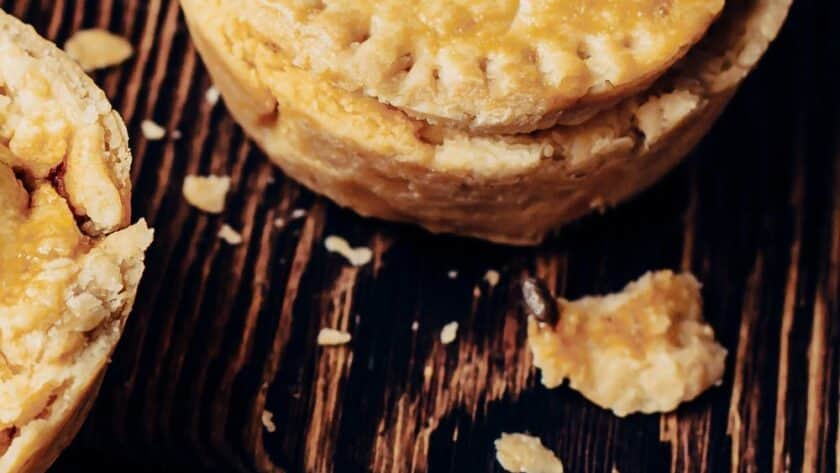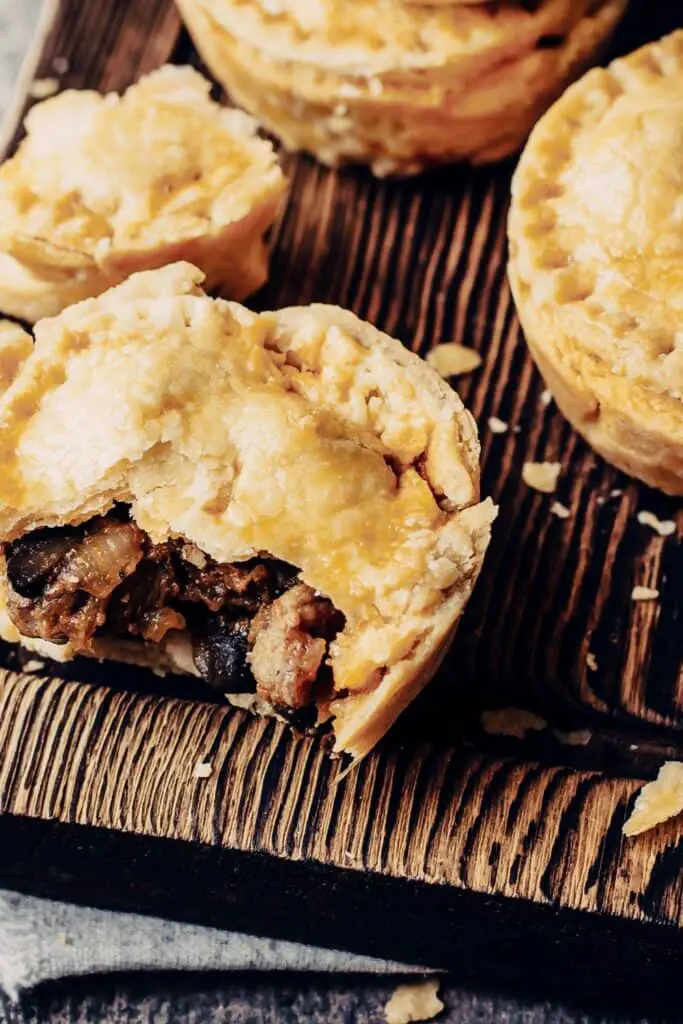Mary Berry’s Suet Pastry is a classic, traditional British pastry made with suet, which is perfect for hearty savory pies and puddings. The texture of suet pastry is rich and slightly denser than other pastries, making it ideal for holding up to robust fillings like steak and kidney or steamed suet puddings. Simple to make and versatile, this pastry adds a deliciously satisfying layer to any dish.
What is Mary Berry Suet Pastry?
Mary Berry’s Suet Pastry is a traditional British pastry made using suet (beef or vegetable fat), flour, and water. It has a tender, flaky texture and is typically used for making meat pies, puddings, and dumplings. Suet pastry is unique for its ability to stay firm while providing a soft, crumbly bite, making it perfect for both baked and steamed dishes.

Other Popular Recipes
Why You Should Try This Recipe
- Traditional and hearty: A staple in British cooking, suet pastry is perfect for classic savory pies.
- Easy to make: With just a few simple ingredients, you can whip up this pastry in no time.
- Great for steamed puddings: Suet pastry holds up beautifully when steamed, making it ideal for sweet or savory puddings.
- Versatile: Works with a variety of fillings, from meaty pies to vegetable-based dishes.
- Perfect texture: Provides a flaky yet firm crust that holds up to heavy fillings.
Ingredients Needed to Make Mary Berry Suet Pastry
- Self-raising flour (225g / 8 oz): The base for the pastry, adding a light and airy texture.
- Suet (100g / 3.5 oz): Use either beef suet or vegetable suet for a flaky, rich pastry.
- Cold water (150ml / 5 fl oz): To bind the ingredients together.
- Pinch of salt: For seasoning and enhancing the flavor.
Equipment Needed
- Mixing bowl
- Rolling pin
- Pastry brush
- Baking dish (if using for a pie)
- Steamer or pudding basin (if making a steamed pudding)
Instructions to Make Mary Berry Suet Pastry
1. Mix the Dry Ingredients:
- Combine flour and suet: In a large mixing bowl, add the self-raising flour, suet, and a pinch of salt. Stir the dry ingredients together until evenly combined.
2. Add Water and Form a Dough:
- Add cold water: Gradually add the cold water, mixing it in with a spoon or your hands until the dough comes together.
- Form the dough: Once the dough is formed, knead it gently until smooth. Be careful not to overwork the dough, as this will toughen the pastry.
3. Roll Out the Pastry:
- Flour your surface: Lightly flour a clean surface and your rolling pin to prevent sticking.
- Roll the dough: Roll out the dough to your desired thickness (usually about ½ cm) depending on what you’re using it for—whether it’s a pie crust or dumplings.
4. Use the Pastry for Your Dish:
- For pies: Line your pie dish with the rolled-out suet pastry, add your filling, and cover with more pastry. Trim the edges and press down with a fork to seal.
- For puddings: If making a steamed pudding, use the pastry to line a pudding basin and add your filling. Place a pastry lid on top before steaming.
5. Cook the Pastry:
- Bake or steam: Depending on your dish, bake the pastry in a preheated oven at 180°C (350°F) for 25-30 minutes until golden brown, or steam the pudding for 1.5 to 2 hours until the pastry is cooked through.

What Goes Well With Mary Berry Suet Pastry
- Steak and kidney pie: A traditional pairing that highlights the robustness of the pastry.
- Steamed pudding: Sweet or savory steamed puddings, like treacle or steak pudding, work wonderfully with suet pastry.
- Vegetable pie: For a vegetarian option, fill the pastry with root vegetables and gravy.
- Dumplings: Suet pastry can be formed into dumplings and added to stews for an extra comforting touch.
Expert Tips for Making the Best Suet Pastry
- Use cold water: Always use cold water when making suet pastry to ensure the fat stays solid and creates the desired flaky texture.
- Don’t overmix: Handle the dough gently to avoid overworking it, which can lead to a tough pastry.
- For a golden finish: If baking, brush the pastry with a beaten egg before cooking for a beautifully golden crust.
- Rest the dough: If you have time, let the dough rest in the fridge for 10-15 minutes before rolling it out, which helps it firm up and be easier to work with.
Easy Variations of Mary Berry Suet Pastry
- Herb-infused: Add finely chopped fresh herbs like thyme or rosemary to the dough for an aromatic twist.
- Sweet version: Add a tablespoon of sugar to the flour if you’re making suet pastry for a sweet dish like a treacle pudding.
- Wholemeal pastry: Swap some of the self-raising flour for wholemeal flour for a more rustic, nutty flavor.
- Vegan option: Use vegetable suet instead of beef suet to make the pastry vegan-friendly.
Best Practices to Store Mary Berry Suet Pastry
- Refrigerate: Wrap the dough tightly in cling film and refrigerate for up to 2 days before using.
- Freeze for later: You can freeze suet pastry for up to 3 months. Just wrap it tightly in cling film and foil. Thaw in the fridge before using.
- Store-cooked pastry: If you’ve baked or steamed the pastry, store leftovers in an airtight container in the fridge for up to 3 days.
Best Practices to Reheat Mary Berry Suet Pastry
- Oven method: Reheat baked suet pastry in the oven at 180°C (350°F) for 10-15 minutes until warmed through.
- Steaming method: For steamed suet puddings, reheat by steaming them again for 20-30 minutes until fully heated.
How Can I Make Mary Berry Suet Pastry Healthier?
- Use vegetable suet: Opt for vegetable suet, which has less saturated fat than traditional beef suet.
- Add whole grains: Replace a portion of the flour with wholemeal flour for added fiber.
- Reduce the suet: You can slightly reduce the amount of suet for a lighter pastry without compromising too much on texture.
Nutrition Value (per serving):
- Calories: 300
- Fat: 15g
- Saturated Fat: 7g
- Carbohydrates: 35g
- Protein: 5g
- Fiber: 2g
FAQs
Can I use vegetable suet instead of beef suet in suet pastry?
Yes, vegetable suet can be used as a direct substitute for beef suet. It works in the same way and is a great option for those who prefer a vegetarian or vegan version of suet pastry.
How do I prevent suet pastry from becoming too heavy?
To keep suet pastry light, avoid overworking the dough. Gently mix the ingredients and handle the pastry minimally to ensure it stays tender and flaky.
Can suet pastry be frozen?
Yes, suet pastry can be frozen either before or after baking. If freezing the dough, wrap it tightly in cling film and freeze for up to 3 months. Thaw in the fridge before rolling out and using.
What is the best filling for suet pastry?
Suet pastry works well with both savory and sweet fillings. Traditional fillings include steak and kidney for savory pies, or treacle and fruit for sweet steamed puddings.
Final Words
Mary Berry’s Suet Pastry is a versatile and hearty addition to your baking repertoire, perfect for both sweet and savory dishes. Its rich texture and ability to hold up to robust fillings make it an excellent choice for pies and puddings alike. With just a few simple ingredients, you can create this traditional pastry at home and enjoy the comforting flavors of classic British cooking!
More By British Baking Recipes
- Jamie Oliver Chicken Pie 5 Ingredients
- Jamie Oliver Leek And Potato Pie
- Jamie Oliver Thai Fish Cakes
- Mary Berry Lancashire Hotpot

Mary Berry Suet Pastry
- Prep Time: 10
- Cook Time: 25
- Total Time: 35 minutes
- Yield: 4
- Category: Pastry
- Method: Baking
- Cuisine: British
Description
Mary Berry’s Suet Pastry is a traditional British pastry made using suet (beef or vegetable fat), flour, and water. It has a tender, flaky texture and is typically used for making meat pies, puddings, and dumplings. Suet pastry is unique for its ability to stay firm while providing a soft, crumbly bite, making it perfect for both baked and steamed dishes.
Ingredients
- Self-raising flour (225g / 8 oz): The base for the pastry, adding a light and airy texture.
- Suet (100g / 3.5 oz): Use either beef suet or vegetable suet for a flaky, rich pastry.
- Cold water (150ml / 5 fl oz): To bind the ingredients together.
- Pinch of salt: For seasoning and enhancing the flavor.
Instructions
1. Mix the Dry Ingredients:
- Combine flour and suet: In a large mixing bowl, add the self-raising flour, suet, and a pinch of salt. Stir the dry ingredients together until evenly combined.
2. Add Water and Form a Dough:
- Add cold water: Gradually add the cold water, mixing it in with a spoon or your hands until the dough comes together.
- Form the dough: Once the dough is formed, knead it gently until smooth. Be careful not to overwork the dough, as this will toughen the pastry.
3. Roll Out the Pastry:
- Flour your surface: Lightly flour a clean surface and your rolling pin to prevent sticking.
- Roll the dough: Roll out the dough to your desired thickness (usually about ½ cm) depending on what you’re using it for—whether it’s a pie crust or dumplings.
4. Use the Pastry for Your Dish:
- For pies: Line your pie dish with the rolled-out suet pastry, add your filling, and cover with more pastry. Trim the edges and press down with a fork to seal.
- For puddings: If making a steamed pudding, use the pastry to line a pudding basin and add your filling. Place a pastry lid on top before steaming.
5. Cook the Pastry:
- Bake or steam: Depending on your dish, bake the pastry in a preheated oven at 180°C (350°F) for 25-30 minutes until golden brown, or steam the pudding for 1.5 to 2 hours until the pastry is cooked through.



